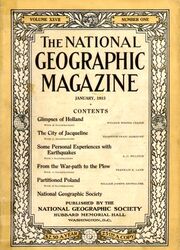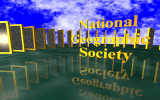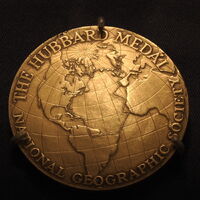
| |
| Motto | |
| Established | 1888 |
| President | John M. Fahey |
| Headquarters | Washington, DC, USA |
| Membership | 8.5 million |
| Founder | Gardiner Greene Hubbard |
| Homepage | www.nationalgeographic.com |
The National Geographic Society, based in Washington, D.C. in the United States, is one of the world's largest not-for-profit educational and scientific organizations. Its interests include geography and natural science, the promotion of environmental and historical conservation, and the study of world culture and history.
Its historical mission is "to increase and diffuse geographic knowledge while promoting the conservation of the world's cultural, historical, and natural resources."[1] Its current President and CEO, John M. Fahey, Jr., says National Geographic's purpose is to inspire people to care about their planet. The Society is governed by a twenty-three member Board of Trustees composed of a group of distinguished educators, businesspeople, scientists, former governmental officials, and conservationists. The organization sponsors and funds scientific research and exploration. The Society publishes an official journal, National Geographic Magazine, and other magazines, books, other publications, web and film products in numerous languages and countries around the world. It also has an educational foundation that gives grants to education organizations and individuals to enhance geography education.[2] Its Committee for Research and Exploration has given grants for scientific research for most of its history and has recently awarded its 9,000th grant for scientific research, conducted worldwide and often reported on by its media properties. Its various media properties reach about 360 million people around the world monthly.[3]
History
The National Geographic Society was founded in Washington, D.C. on January 27, 1888, by 33 explorers and scientists who were interested in "organizing a society for the increase and diffusion of geographical knowledge." They had begun discussing forming the Society two weeks earlier on January 13, 1888, before gathering at the Cosmos Club, a private club then located on Lafayette Square near the White House. Gardiner Greene Hubbard became its first president and his son-in-law, Alexander Graham Bell, eventually succeeded him. Bell's son-in-law Gilbert Hovey Grosvenor was named the first full-time editor of National Geographic Magazine, and members of the Grosvenor family have played important roles in the organization since. Bell and his son-in-law, Grosvenor, devised the successful marketing notion of Society membership and the first major use of photographs to tell stories in magazines. The current Chairman of the Board of Trustees of National Geographic is Gilbert Melville Grosvenor, who received the Presidential Medal of Freedom in 2005 for the Society's leadership for Geography education. National Geographic received the prestigious Prince of Asturias Award for Communications and Humanity in October 2006 in Oviedo, Spain.
Publications
National Geographic magazine
- Main article : National Geographic Magazine

Cover of January, 1915 National Geographic
The National Geographic Magazine, later shortened to National Geographic, published its first issue nine months after the Society was founded as the Society's official journal, a benefit for joining the tax exempt National Geographic Society. The magazine has had for many years a trademarked yellow border around the edge of its cover.
There are 12 monthly issues of National Geographic per year, plus at least four additional map supplements. On rare occasions, special issues of the magazine are also created. The magazine contains articles about geography, popular science, world history, culture, current events and photography of places and things all over the world and universe. The National Geographic magazine is currently published in 31 language editions in many countries around the world.
Other publications
In addition to its flagship magazine, the Society publishes four other periodicals in the United States:
- National Geographic Kids: launched in 1975 as National Geographic World, name changed in 2001. There are currently 14 local language editions of NG Kids.
- National Geographic Traveler: launched in 1984. There are some six language editions of NG Traveler other than English.
- National Geographic Adventure: launched in 1999
- National Geographic Explorer: classroom magazine launched in 2001 as National Geographic for Kids
The Society previously published:
- The National Geographic School Bulletin, magazine similar to the National Geographic but aimed at grade school children, was published weekly during the school year from 1919 to 1975, when it was replaced by National Geographic World.
- During the 1980s and 1990s, it published a research journal which later closed.
The Society has also published maps, atlases, and numerous books.
Television

Replica of the animation used at the beginning of National Geographic documentaries
- Main article : National Geographic Channel
Stories by the National Geographic Society are shown on television. National Geographic specials as well as television series have been shown on PBS and other networks in the United States and terrestrially globally for many years. The Geographic series in the U.S. started on CBS in 1964, moved to ABC in 1973 and shifted to PBS (produced by WQED, Pittsburgh) in 1975. It has featured stories on numerous scientific figures such as Louis Leakey, Jacques Cousteau, or Jane Goodall that not only featured their work but helped make them world-famous and accessible to millions. The specials' theme music, by Elmer Bernstein, was also adopted by the National Geographic Channel.
In 1997 internationally and in 2001 in the United States, the Society launched, in part ownership with other entities like News Corporation and NBC, television network, the National Geographic Channel (NGC) for cable and satellite viewers, which has global distribution.
National Geographic has also produced a feature film based on the diary of a Russian submarine commander starring Harrison Ford in K-19: The Widowmaker, and most recently retooling a French-made documentary for U.S. distribution with a new score and script narrated by Morgan Freeman called March of the Penguins, which received an Academy Award for the Best Documentary in 2006. After a record $77 million theatrical gross in the United States, more than four million of the Penguin DVDs were sold. The National Geographic website (nationalgeographic.com) provides a wealth of content in multimedia formats, including a recently launched site highlighting world music.
Support for research & projects
The Society has helped sponsor many expeditions and research projects over the years, including:
- Codex Tchacos - (conservation and translation of the only known surviving copy of the Gospel of Judas)
- Ian Baker (Discovers hidden waterfall of the Tsangpo Gorge, Tibet)
- Robert Ballard - (RMS Titanic and John F. Kennedy's PT-109 discovery)
- Robert Bartlett - (Arctic Exploration)
- George Bass - (Undersea archaeology - bronze age trade)
- Lee Berger - (Oldest footprints of modern humans ever found)
- Hiram Bingham - (Machu Picchu Excavation)
- Richard E. Byrd - (First flight over South Pole)
- Jacques-Yves Cousteau - (Undersea exploration)
- Mike Fay - (MegaTransect and MegaFlyover in Africa)
- Dian Fossey - (Mountain gorillas)
- Birute Galdikas - (Orangutans)
- Jane Goodall - (Chimpanzees)
- Robert F. Griggs - (Valley of Ten Thousand Smokes)
- Heather Halstead - World Circumnavigations of Reach the World
- Louis and Mary Leakey - (Discovery of manlike Zinjanthropus, more than 1.75 million years old)
- Gustavus McLeod - (First flight to the North Pole in an open-air cockpit aircraft)
- Robert Peary and Matthew Henson - (North Pole Expedition)
- Paul Sereno - (Dinosaurs)
- Will Steger - (Polar Exploration & First Explorer-in-Residence 1996) [4]
- Jonathan B. Tourtellot - Geotourism Forum Editor at Traveler.
- Spencer Wells - (The Genographic Project)
- Xu Xing - (Discovery of fossil dinosaurs in China that have distinct feathers)
The Society sponsors many socially-based projects including AINA, a Kabul-based organization dedicated to developing an independent Afghan media.
The Society also sponsors the National Geographic Bee, an annual geographic contest for American middle-school students. More than four million students a year begin the geography competition locally, which culminates in a national competition of the winners of each state each May in Washington, D.C. Jeopardy! host Alex Trebek has moderated the final competition since the competition began some seventeen years ago. Every two years, the Society conducts an international geography competition of competing teams from all over the world. The most recent was held in Budapest, Hungary during the summer of 2005, and had representatives from 18 country teams.
Hubbard Medal

Anne Lindbergh's customized medal detailing her flight route
The Hubbard Medal is awarded by the National Geographic Society for distinction in exploration, discovery, and research. The medal is named for Gardiner Greene Hubbard, first National Geographic Society president.
The Hubbard Medal has been presented 33 times in the past. Recipients include polar explorers Robert Peary in 1906, Roald Amundsen in 1907, Capt. Robert Bartlett in 1909, Sir Ernest Shackleton in 1910 and Richard E. Byrd in 1926; aviators Charles Lindbergh in 1927 and Anne Morrow Lindbergh in 1934; anthropologists Louis Leakey and Mary Leakey in 1962; Apollo 11 astronauts Neil Armstrong, Edwin Aldrin and Michael Collins in 1970; anthropologist Richard Leakey in 1994; conservationist Jane Goodall in 1995; underwater explorer Robert Ballard in 1996; and balloonists Bertrand Piccard and Brian Jones in 1999.
References
- ↑ National Geographic Online. National Geographic Society.
- ↑ National Geographic Education Foundation. National Geographic Society.
- ↑ National Geographic Society. U.S. Department of State.
- ↑ Explorer-in-Residence
Further reading
- Poole, Robert M. Explorers House: National Geographic and the World it Made. New York: Penguin, 2004. {ISBN|1594200327}
See also
- Royal Geographical Society
- Royal Canadian Geographical Society
- Maps of the United States
External links
- Official websites
- Additional information
-
- "How They Found National Geographic's 'Afghan Girl'" (March 7, 2003)
- Website criticising the National Geographic on geographical names—describes the Iranian geographic naming controversy
- National Geographic and the National Iranian American Council discuss the naming dispute (NIAC press release dated December 7, 2004)
- Photos, maps, and other images
- National Geographic related humor